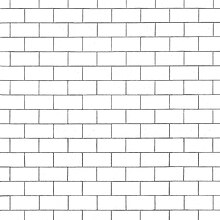| The Wall | ||||
|---|---|---|---|---|
 Original copies had black or red text reading "Pink Floyd The Wall" stickered in the centre. | ||||
| Studio album by | ||||
| Released | 30 November 1979 | |||
| Recorded | December 1978 – November 1979 | |||
| Studio |
| |||
| Genre | ||||
| Length | 80:42 | |||
| Label | ||||
| Producer | ||||
| Pink Floyd chronology | ||||
| ||||
| Singles from The Wall | ||||
| ||||
The Wall is the eleventh studio album by the English rock band Pink Floyd, released on 30 November 1979 by Harvest/EMI and Columbia/CBS Records. It is a rock opera which explores Pink, a jaded rock star, as he constructs a psychological "wall" of social isolation. The Wall topped the US charts for 15 weeks and reached number three in the UK. It initially received mixed reviews from critics, many of whom found it overblown and pretentious, but later received accolades as one of the greatest albums of all time.
The bassist, Roger Waters, conceived The Wall during Pink Floyd's 1977 In the Flesh tour, modelling the character of Pink after himself and the former member Syd Barrett. Recording spanned from December 1978 to November 1979. The producer Bob Ezrin helped to refine the concept and bridge tensions during recording, as the band members were struggling with personal and financial problems. The keyboardist, Richard Wright, was fired by Waters during production but stayed on during the tour as a salaried musician.
Three singles were issued: "Another Brick in the Wall, Part 2" (Pink Floyd's only UK and US number-one single), "Run Like Hell", and "Comfortably Numb". From 1980 to 1981, Pink Floyd performed the album on a tour that featured elaborate theatrical effects. In 1982, The Wall was adapted into a feature film written by Waters.
The Wall is one of the best-known concept albums.[4] With over 30 million copies sold, it is the second-best-selling Pink Floyd album behind The Dark Side of the Moon (1973), the best-selling double album of all time,[5] and one of the best-selling albums of all time.[6] Some outtakes sessions were used on the next Pink Floyd album, The Final Cut (1983). In 2000, it was voted number 30 in Colin Larkin's All Time Top 1000 Albums.[7] In 2003, 2012, and 2020, it was included in Rolling Stone's lists of the "500 Greatest Albums of All Time".[8] From 2010 to 2013, Waters staged a new Wall live tour that became one of the highest-grossing tours by a solo musician.
- ^ Murphy, Sean (17 November 2015). "The 25 Best Classic Progressive Rock Albums". PopMatters. Archived from the original on 11 June 2016. Retrieved 7 June 2016.
- ^ Brown, Jake (2011). Jane's Addiction: In the Studio. SCB Distributors. p. 9. ISBN 978-0-9834716-2-2. Archived from the original on 19 August 2020. Retrieved 1 November 2016.
- ^ Breithaupt, Don; Breithaupt, Jeff (2000), Night Moves: Pop Music in the Late '70s, St. Martin's Press, p. 71, ISBN 978-0-312-19821-3, archived from the original on 22 February 2017, retrieved 12 March 2016
- ^ Barker, Emily (8 July 2015). "23 of the Maddest And Most Memorable Concept Albums". NME. Archived from the original on 13 January 2017. Retrieved 23 January 2017.
- ^ "Pink Floyd's The Wall: The secrets behind 1980's best selling album". loudersound.com. 3 September 2018. Archived from the original on 14 February 2022. Retrieved 13 February 2022.
- ^ Cite error: The named reference
worldwide saleswas invoked but never defined (see the help page). - ^ Colin Larkin (2000). All Time Top 1000 Albums (3rd ed.). Virgin Books. p. 48. ISBN 0-7535-0493-6.
- ^ "The 500 Greatest Albums of All Time". Rolling Stone. 22 September 2020. Archived from the original on 10 December 2020. Retrieved 24 September 2020.